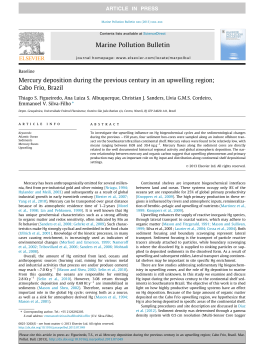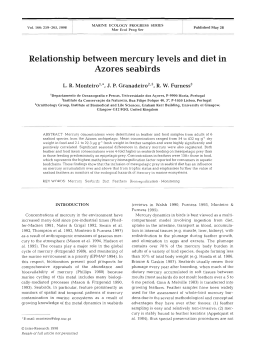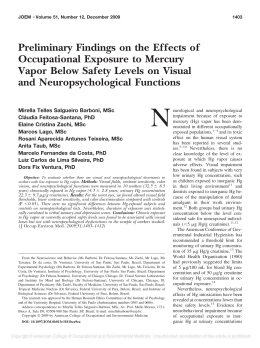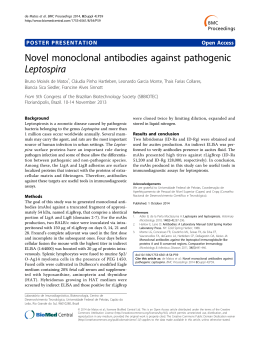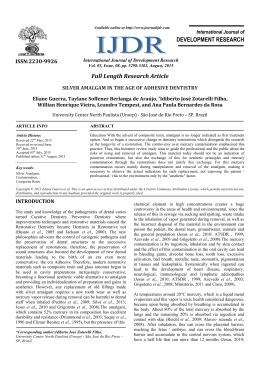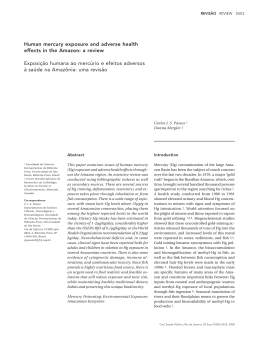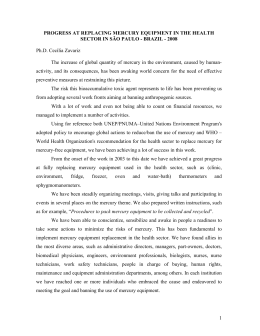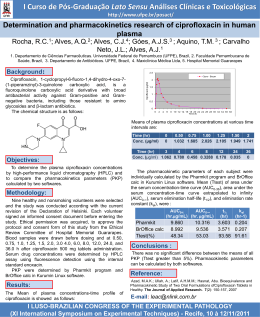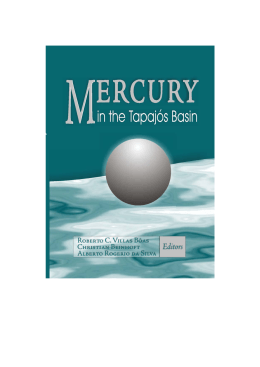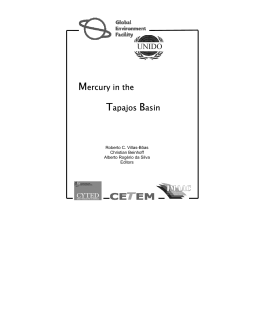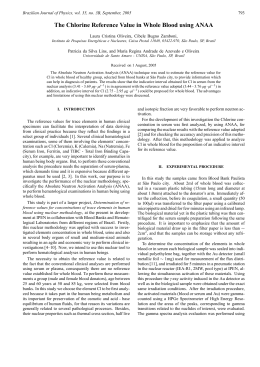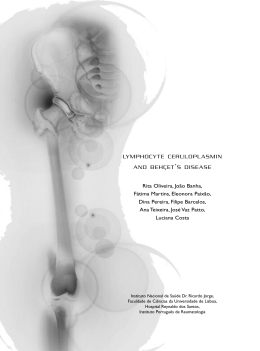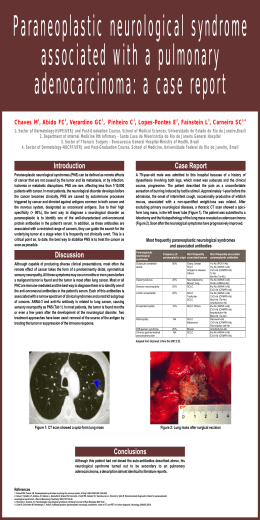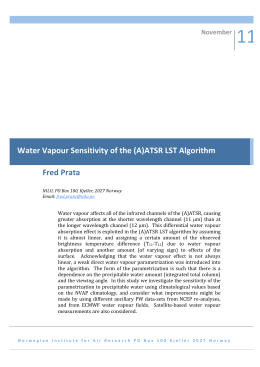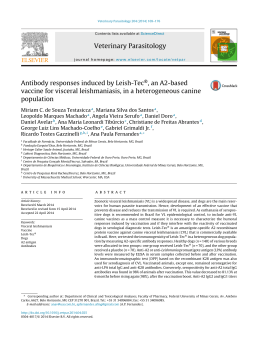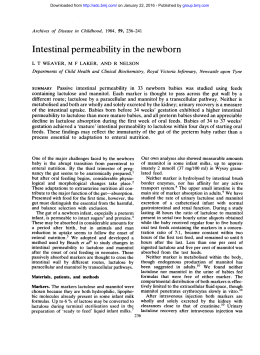Nephrol Dial Transplant (2001) 16: 2253–2255 Case Report Membranous nephropathy from exposure to mercury in the fluorescent-tube-recycling industry Serhat Aymaz1, Oliver Groß1, Bernd Krakamp1, Monika Ortmann2, Haw Peter Dienes2 and Manfred Weber1 1 Medical Clinic I, Cologne City Hospital, Teaching Hospital University of Cologne and 2Department of Pathology, University of Cologne, Germany Keywords: exposure membranous nephropathy; mercury exposure to mercury vapour in the fluorescent-tuberecycling industry. Introduction Case 1 Mercury is a silvery white liquid metal that is volatile at room temperature due to its high vapour pressure. It exists in different oxidation states and can form a number of compounds. Mercury and its compounds can be absorbed into the human body by inhalation, ingestion, and through the skin. It is toxic when certain threshold values are exceeded. Acute toxicity is due to the inactivation of enzymes by the heavy metal, which leads to interstitial pneumonitis, ulcerative gastro-enteritis, or tubular necrosis, depending on the route of exposure. Long-term mercury poisoning affects mainly the central nervous system and the kidneys. In the latter case the nephrotoxicity is usually manifested as membranous glomerulonephritis (MGN) with nephrotic syndrome. Since 1920, numerous cases of nephrotic syndrome due to long-term contact with mercury and mercury compounds have been reported. Mercurial diuretics (Mersalyl1), teething powders for young children, and mercury-containing ointments for psoriasis were the main sources of exposure in medicine w1,2x. In 1962, MGN was demonstrated by renal biopsy in five cases of nephrotic syndrome due to psoriasis ointments containing mercury w3x. MGN due to skin-lightening creams containing mercury was reported last in 1987 w4x. In industry, mercury is still used in gold mines, in chlor-alkali plants, and in the manufacture of batteries. In daily life, it occurs in technical and control instruments. Here we report for the first time two cases of membranous nephropathy due to occupational A 49-year-old worker was admitted to our hospital because of suspected mercury intoxication. About 6 months before admission the patient had started work in a factory where fluorescent tubes were recycled, but after 6 weeks he felt weakness, suffered from intermittent headaches, experienced nausea, vomiting, lack of appetite, and insomnia, and noticed changes in his personality such as excitability and depression. There was no personal or family history of renal disease, oedema, hypertension, or psychiatric problems. Physical examination showed a man of 170 cm height and 73 kg body weight, in balanced hydration, and without pathological signs in lungs, heart, abdomen, or nervous system. Blood pressure was 130u70 mmHg and heart rate was 72 beats per min. Laboratory investigations revealed decreased total serum protein (5.4 gudl), increased serum cholesterol (425 mgudl), and 4q proteinuria. Urinary sediments showed 0–1 white blood cells, 0–3 red blood cells, and some hyaline casts by phase-contrast microscopy (400 3 ). The 24-h urine protein excretion was 7.7 g, creatinine clearance 124 mlumin. Haemoglobin was 17.6 gudl, haematocrit 52.4%, platelets 286unl, and the white blood cell count was 11.2unl with a normal differential. Serum sodium, potassium, creatinine, and BUN were within normal ranges. Antibodies against nuclear antigens (ANA), mitochondria (AMA), and neutrophil cytoplasmic antigens (ANCA) could not be detected. Serum complement studies showed normal C4 and increased C3 (157 mgudl). Serum electrophoresis showed a decrease of albumin to 2.7 gudl (50.5% of normal) and an increase of the alpha-2 fraction (18.5%). An elevation of IgE (266 Uuml) was observed, but IgG (7.1 gul), IgM (0.83 gul), and IgA (4.3 gul) were normal. HBs antigen and antibodies against HBs, HBc, and HCV were not detectable. Correspondence and offprint requests to: Manfred Weber MD, Medical Clinic I, Cologne City Hospital, Ostmerheimer Str. 200, D-51058 Cologne, Germany. # 2001 European Renal Association–European Dialysis and Transplant Association 2254 On ultrasonography, the length of the right kidney was 10.3 cm, of the left kidney 10.0 cm, and both kidneys were of normal shape. Further tests revealed an elevated blood mercury concentration of 11.1 mgul and an increased urinary mercury excretion of 118 mgul. Reference values in the non-exposed population are approximately 8 mgul in blood and 4 mgul in urine. A mercury-removal test with 2.3-dimercapto-propane-1-sulphonate (DMPS) was performed: oral application of 300 mg DMPS was followed by a 24-h urine collection. The total amount of mercury excreted was significantly elevated at 2208 mgul, indicating a high body concentration. Case 2 A 47-year-old man was admitted to our hospital because of nephrotic syndrome. The patient had started working in the same factory as in case 1 about 6 months before admission. He was personally involved in recycling fluorescent tubes. Six weeks prior to admission he noted painless swelling of both legs and accompanying weakness. He did not complain of other health problems. There was no personal or family history of renal disease, oedema, or hypertension. Physical examination showed an overweight man (176 cm height and 107 kg body weight), in no distress. Both legs were oedematous up to the knees. There were no pathological findings in the lungs, heart, abdomen, or nervous system. Blood pressure was 150u90 mmHg and heart rate was 82 beats per min. Laboratory investigation revealed decreased total serum protein (5.6 gudl), increased serum cholesterol (352 mgudl), and a 3q proteinuria. Microscopic examination of urinary sediment showed 0–2 white blood cells, 2–5 red blood cells, and some hyaline casts. The 24-h urine protein excretion was 12.3 g and creatinine clearance was 157 mlumin. Blood cell count, haemoglobin, platelets, serum sodium, potassium, creatinine, and BUN were within normal ranges. ANA, AMA, ANCA, and antibodies against laminin could not be detected. C4 was normal but C3 was increased to 175 mgudl. An elevation of IgE (1342 Uuml) and a decrease of IgG (3.1 gul) were noted, but IgM (1.13 gul) and IgA (1.05 gul) were within normal limits. Antibodies against hepatitis C were not detectable. Anti-HBc and anti-HBe antibodies were present, whereas HBs-antigen and anti-HBs antibodies were not detectable. Ultrasonography showed kidneys of 13 cm length and of regular shape. Mercury concentrations were increased in blood (41.2 mgul) and urine (158 mgul). After oral administration of 300 mg DMPS, urinary mercury excretion increased to 1242 mgul. Histological findings Renal biopsies revealed MGN in both cases. On light microscopy there were no significant pathological S. Aymaz et al. alterations in Bowman’s space, the mesangial cells, or the basement membrane. The interstitium was moderately oedematous and hyaline material was present in the tubular lumina. Immunofluorescence revealed granular deposits of IgG and C3 along the glomerular basement membrane. Electron microscopy revealed subepithelial electron-dense deposits and an effacement of the foot processes of visceral epithelial cells. Follow-up The first patient was lost to follow-up and information is available only in case 2. This patient stopped working in the tube-recycling factory. Two years after withdrawal from exposure, mercury concentrations in blood (0.5 mgul) and urine (0.5 mgul) had fallen below reference values for non-exposed populations. The 24-h urine protein excretion decreased from 12.3 to 0.32 g and creatinine clearance was 112 mlumin. Discussion Fluorescent tubes contain 10–25 mg metallic mercury vapour per tube, which emits ultraviolet radiation. This vapour is released when the lamps are recycled and can be absorbed by inhalation; 80% is retained in the human body after oxidation to Hg2q w5,6x. In these two cases the patients developed MGN about 6 months after starting work in a factory where they were personally involved in recycling fluorescent tubes. Using an atomic absorption method to measure urinary mercury excretion, we demonstrated high concentrations of mercury in their bodies. The urinary concentrations of mercury were 15–20 times higher than reference values for non-exposed populations. MGN has been reported in association with mercury and gold, whereas other precious metals such as silver or titanium do not induce MGN. We therefore concluded that these patients had developed mercury-induced MGN. In humans, the pathomechanism of mercuryinduced MGN has not been elucidated. Experimental studies in rats point to a genetic susceptibility and to polyclonal stimulation of the immune system in mercury-induced MGN. Brown–Norway (BN) rats, Dorus–Zadel black rats, and MAXX rats developed MGN after administration of HgCl2, whereas in other strains GN could not be induced by mercury w7,8x. In addition, the exposure of BN rats to Hg vapour induced a membranous nephropathy w9x. The underlying pathogenetic mechanism is characterized by a T-lymphocyte-dependent polyclonal B-cell activation, with subsequent production of autoantibodies against proteins of the glomerular basement membrane (GBM) such as laminin and fibronectin, and also against heparan sulphate proteoglycans w10,11x. It is not Membranous nephropathy from mercury in the fluorescent-tube industry known whether similar mechanisms operate in humans. The results of epidemiological studies in workers exposed to mercury are inconsistent concerning renal function and immune reaction. We could not demonstrate anti-laminin antibodies in case 2. However, this patient had been admitted at least 8 weeks after exposure to mercury had ceased, and antibody titres may already have decreased below the limit of detection. In addition, antibodies might be not detectable because of low circulating concentrations due to complex building with target antigens in the GBM. Theoretically, polyclonal B-cell activation might result in the production of antibodies against membrane proteins of visceral epithelial cells similar to those in experimental Heymann nephritis (HN). Such antibodies render specificity to epitopes of a glycoprotein on membranes of visceral epithelial cells, designated megalinugp330. In-situ immune-complex formation results in subepithelial immune deposits and proteinuria in HN w12x. However, evidence supporting this hypothesis has not yet been reported in humans. During follow-up, case 2 patient went into remission with a urinary protein excretion of only 0.32 guday after withdrawal from exposure to mercury. Similar good results have been reported in gold-induced MGN. Secondary MGN is commonly associated with infections, malignancies, SLE and drugs such as gold salts and D-penicillamine. The cases reported here emphasize the importance of enquiring into patients’ social histories for possible associations. 2255 References 1. Wilson VK, Thomson ML, Holzel A. Mercury nephrosis in young children—with special reference to teething powders containing mercury. BMJ 1952; 1: 358–360 2. Burston J, Darmady EM, Stranack F. Nephrosis due to mercurial diuretics. BMJ 1958; 31: 1277–1279 3. Becker CG, Becker EL, Maher JF, Schreiner GE. Nephrotic syndrome after contact with mercury. Arch Intern Med 1962; 110: 178–186 4. Oliveira DBG, Foster G, Savill J, Syme PD, Taylor A. Membranous nephropathy caused by mercury-containing skin lightening cream. Postgrad Med J 1987; 63: 303–304 5. Halbach S, Clarkson TW. Enzymatic oxidation of mercury vapours by erythrocytes. Biochem Biophys Acta 1978; 523: 522–531 6. Hursh JB, Clarkson TW, Cherian MG, Vostal JV, Mallie RV. Clearance of mercury vapour inhaled by human subjects. Arch Environ Health 1976; 31: 302–309 7. Sapin C, Druet E, Druet P. Induction of anti-glomerular basement membrane antibodies in the Brown-Norway rat by mercuric chloride. Clin Exp Immunol 1977; 28: 173–179 8. Aten J, Veninga A, Bruijn JA, Prins FA, De Heer E, Weening JJ. Antigenic specificities of glomerular-bound autoantibodies in membranous glomerulopathy induced by mercuric chloride. Clin Immunol Immunopathol 1992; 63: 89–102 9. Hua J, Pelletier L, Berlin M, Druet P. Autoimmune glomerulonephritis induced by mercury vapour exposure in the Brown Norway rat. Toxicology 1993; 79: 119–129 10. Icard P, Pelletier L, Vial MC et al. Evidence for a role of antilaminin-producing B cell clones that escape tolerance in the pathogenesis of HgCl2-induced membranous glomerulopathy. Nephrol Dial Transplant 1993; 8: 122–127 11. Fukatsu A, Brentjens JR, Killen PD, Kleinmann HK, Andres GA. Studies on the formation of glomerular immune deposits in BN rats injected with mercuric chloride. Clin Immunol Immunopathol 1987; 45: 35–47 12. Hörl WH, Kerjaschki D. Membranous glomerulonephritis (MGN). J Nephrol 2000; 13: 291–316 Received for publication: 18.11.00 Accepted in revised form: 4.5.01
Download
